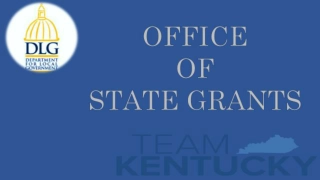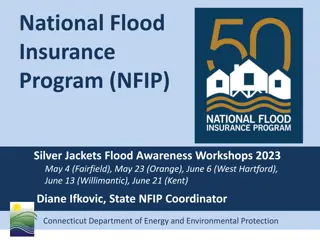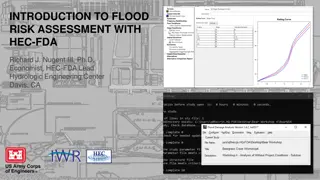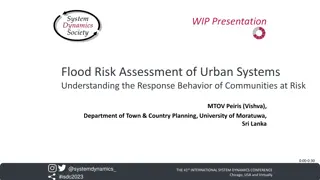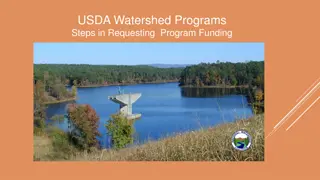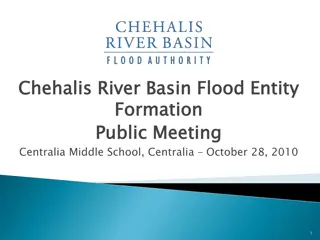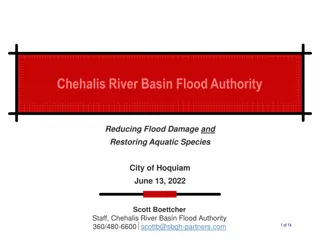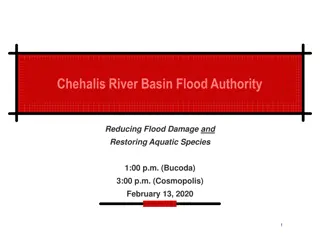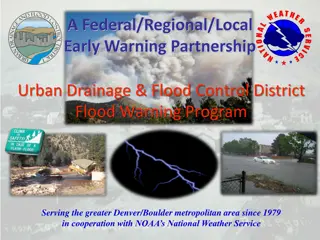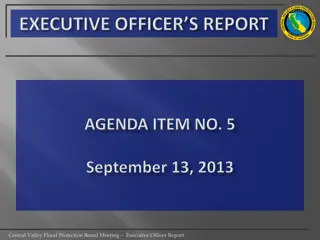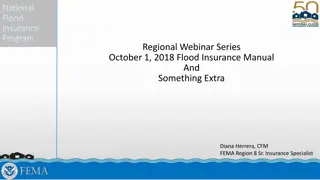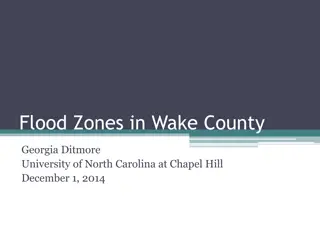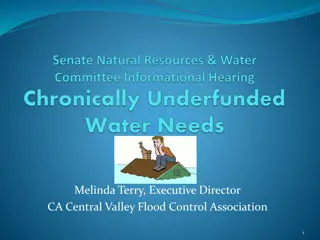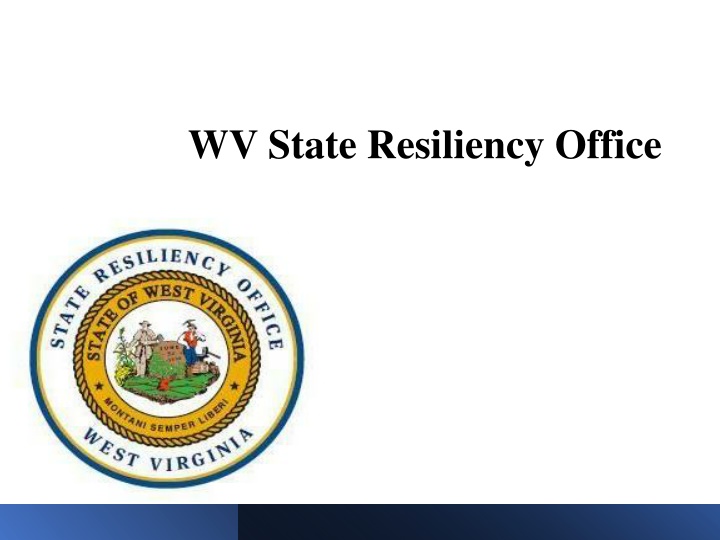
State Resiliency Office Roles and Responsibilities
Discover the key roles and responsibilities of the State Resiliency Office in West Virginia, including coordinating flood projects, improving flood plain management, providing education on flooding issues to citizens, and securing funds for long-term recovery and resiliency efforts.
Download Presentation

Please find below an Image/Link to download the presentation.
The content on the website is provided AS IS for your information and personal use only. It may not be sold, licensed, or shared on other websites without obtaining consent from the author. If you encounter any issues during the download, it is possible that the publisher has removed the file from their server.
You are allowed to download the files provided on this website for personal or commercial use, subject to the condition that they are used lawfully. All files are the property of their respective owners.
The content on the website is provided AS IS for your information and personal use only. It may not be sold, licensed, or shared on other websites without obtaining consent from the author.
E N D
Presentation Transcript
WV SRO Update 1. 2024 Session Resiliency and Recovery Funds were omitted from the budget. No changes to 29-31 2. SBP Fellow Sarah Hambrick - 2-year stent targeting funding 3. BRIC grant application for the CHAT Program county capacity 4. Looking at various other grants for staffing positions related to long term recovery 5. NSF Project Flood Resiliency Framework 6. Flood Resiliency Plan
WV Code 29-31 Refresher (1) Serve as coordinator of all economic and community resiliency planning and implementation efforts, including, but not limited to, flood protection programs and activities in the state; (2) Develop a new state Flood Resiliency Plan due to the Board no later than June 30, 2024; (3) Coordinate an annual review of the state Flood Resiliency Plan and update the plan no less than biennially, with updates due to the board no later than June 30 in even-numbered years; (4) Recommend legislation to reduce or mitigate flood damage; (5) Report to the Joint Legislative Committee on Flooding at least quarterly; (6) Catalog, maintain, and monitor a listing of current and proposed capital expenditures to reduce or mitigate flood damage and other hazards, and other useful and desirable resiliency efforts;
SRO Roles and Responsibilities (7) Coordinate planning of flood projects with federal agencies; (8) Improve professional management of flood plains; (9) Provide education and outreach on flooding issues to the citizens of this state; (10) Establish a single website integrating all agency flood information; (11) Monitor federal funds and initiatives that become available for disaster recovery and economic and community resiliency or other flood or hazard mitigation, and to direct expenditures on behalf of the Governor; (12) Pursue additional funds and resources to assist not only with long-term recovery efforts but also long-term community and statewide resiliency efforts; (13) Coordinate, integrate, and expand planning efforts in the state for hazard mitigation, long-term disaster recovery, and economic diversification; (14) Coordinate long-term disaster recovery efforts in response to disasters as they occur;
SRO Roles and Responsibilities (15) Establish and facilitate regular communication between federal, state, local, and private sector agencies, and organizations to further economic and disaster resilience; (16) Receive resources, monetary or otherwise, from any other governmental entity and disburse those resources to effectuate the purposes of this article; (17) Execute cooperative agreements, where appropriate, between the State Resiliency Office and the federal and/or state governments; (18) Contract, where appropriate, on behalf of the State Resiliency Office, with the federal government, its instrumentalities and agencies, any state, territory or the District of Columbia, and its agencies and instrumentalities, municipalities, foreign governments, public bodies, private corporations, partnerships, associations, and individuals; (19) Use funds administered by the State Resiliency Office for the maintenance, construction, or reconstruction of capital repair and replacement items as necessary to effectuate the purposes of this article;
SRO Roles and Responsibilities (20) Accept and use funds from the federal government, its instrumentalities and agencies, any state, territory or the District of Columbia, and its agencies and instrumentalities, municipalities, foreign governments, public bodies, private corporations, partnerships, associations, and individuals for the purposes of disaster recovery, hazard mitigation, flood mitigation, flood prevention, and disaster response programs; (21) Hire necessary employees at an appropriate salary equivalent to a competitive wage rate; (22) Enroll appropriate employees in PERS, PEIA, and workers compensation and unemployment programs, or their equivalents: Provided, That the State Resiliency Office, through the receipt of federal and/or state funds, pays the required employer contributions; (23) Develop a human resources division that will administer and manage its employees and receive state matching funds as necessary to ensure maximum federal funds are secured; (24) Have the ability to secure all other bonding, insurance, or other liability protections necessary for its employees to fulfill their duties and responsibilities;
SRO Roles and Responsibilities (25) Have the ability to draw upon other departments, divisions, agencies, and all other subdivisions of the state for research and input in fulfilling the requirements of this article, and its requests are to have priority over other such requests; (26) Participate in the interdepartmental transfer of permanent state employees, as if he or she were a department secretary, under the provisions of 5F-2-7 of this code. (27) Notwithstanding any other provision of this code to the contrary, acquire legal services that are necessary, including representation of the board, its employees, and officers before any court or administrative body from the office of the Attorney General, who shall provide such legal assistance and representation, and (28) Take all other actions necessary and proper to effectuate the purposes of this article. The office shall have any other additional authority, duties, and responsibilities as prescribed by the Governor to effectuate the purposes of this article. Due to the at- will employment relationship with the office, its employees may not avail themselves of the state grievance procedure as set forth in 6C-2-1 et seq. of this code.
2022 FLOOD PLAN REVIEW The focus was placed on determining what goals, objectives, and recommendations from the 2004 Plan have been met, are still in progress or are no longer relevant. Feedback was first sought out from pertinent state agencies, federal entities, and non-governmental organizations (NGOs). The 2022 West Virginia Flood Symposium provided an opportunity to seek feedback on the plan from subject matter experts from varying backgrounds. Participants included academics, flood plain managers, legislators, state employees, federal partners, and NGO attendees.
Consensus was that the six goals laid out in the 2004 Plan are still relevant. 1. 2. Reduce the unnecessary loss of lives due to flooding. Reduce private and public property damages due to flooding. Develop technical and administrative tools to flood loss reduction and floodplain Promote technical and legislative tools that will reduce excessive runoff from land conversion activities. Reduce personal and economic loss due to flooding while supporting State economic growth. Protect the State s waterways and floodplain environments. 3. manage management. 4. 5. 6.
Flood Resiliency Plan The Goals, Objectives and Recommendations have been taken from the 2004 Flood Plan. Utilize an annual symposium to assist in reviewing, updating, and monitoring the plan. Digital Use Implement a Read What You Need scenario. Resiliency Dashboard to catalog investment and to establish a moving trend line.
Flood Resiliency Plan I. Authorization and Document Guide II. Executive Summary III. Prioritization 1. Implement recommendations that support existing plans, programs, and laws as well leverage grant funding 2. Utilize and develop data in determining where to focus efforts 3. Employ a multiple benefit approach Detailed examples of each type are provided
Flood Resiliency Plan IV. Recommended Actions by Sector & Organization (Flood Plan) A. Federal Organizations 1. Legislative Branch 2. Executive Branch 3. Agencies B. State Organizations 1. Legislative Branch 2. Executive Branch 3. Agencies, Commissions, and Boards
Flood Resiliency Plan C. Regional Organizations 1. Conservation Districts 2. Regional Planning and Development Councils D. County Organizations E. Municipalities F. Communities G. NGOs H. Utilities I. Businesses J. Residents
Flood Resiliency Plan V. Progress and Tracking A. Dollars expended 1. Mitigation projects 2. Other projects (Dam rehab, Flood walls, Maintenance 3. Training 4. Education & outreach 5. Research and studies B. Projects completed C. Objectives and recommendations met D. Educational output and participation E. Website and social media hits F. Crowd sourced feedback (annual survey, annual/biennial symposium) G. Legislation passed VI. Appendices
Questions, Comments, or Discussion?
Director Robert T. Martin: robert.t.martin@wv.gov Deputy Director Edwin R. Martin: edwin.r.martin@wv.gov Contact Administrative Assistant Lindsey Hanks: lindsey.c.hanks@wv.gov 304-352-0734

